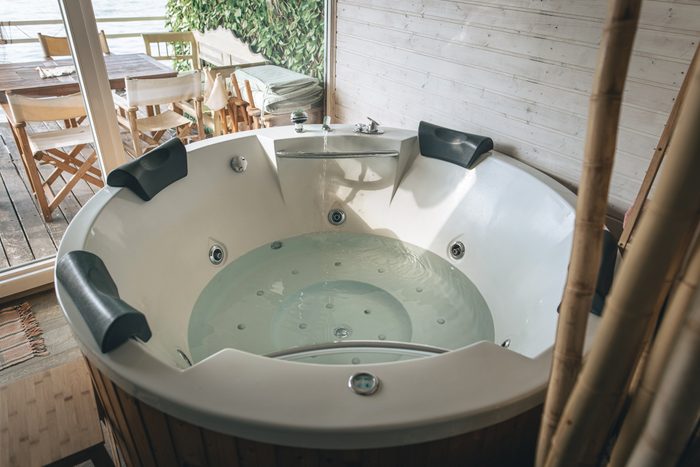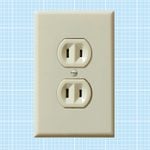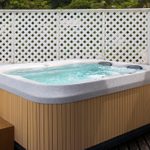How To Wire an Indoor Hot Tub

If you've been dreaming about installing an indoor hot tub and you're considering doing the wiring yourself, here's what you should know.
Our editors and experts handpick every product we feature. We may earn a commission from your purchases.
You’ve got extra space in your lower-level recreation room and can picture your family enjoying a warm, bubbling hot tub. If you’re confident in your electrical skills, you might decide to do the wiring yourself. Read on to learn how.
Like many projects, careful planning is a must to ensure proper installation. Always remember, safety first.
Here’s some additional advice about outdoor hot tub wiring and questions to ask before you buy a hot tub.
On This Page
Before You Start Your Indoor Hot Tub Wiring Project
Don’t proceed until you’ve considered the following:
Type of hot tub
There’s more than one kind of hot tub (aka spa), and the National Electrical Code (NEC) has different rules for different types. Here, we’re talking about self-contained hot tubs.
The hot tub should include a label indicating it’s approved for indoor use. Look for a manufactured unit that includes the tub vessel, water pumps, water heaters and control equipment, all entirely under the skirt.
Hot tub safety certification
Be sure the hot tub is certified and labeled by a nationally recognized testing laboratory like UL, ETL, CSA, MET or another accredited product evaluation and certification organization.
Location
For safety, receptacle outlets, lighting, switches and other electrical apparatus must be out of reach of people in the tub.
Self-contained hot tubs feature a removable panel for access to the main electrical control panel, water pumps and other equipment within the skirting. Make sure there’s at least 36 inches of permanent space in front of the access panel.
Electrical capacity
A hot tub uses a lot of power. This usually requires a dedicated feeder or branch circuit rated at 120/240 volts, and anywhere from 30 to 50 amperes.
Electrical connection
Self-contained tubs may be cord connected, convertible or permanently wired.
A convertible hot tub comes from the factory with a power-supply cord but may be field-converted for a permanent connection.
Permits and inspections
Whether you install the wiring yourself or hire a licensed electrical contractor, your local building inspection office will require permits and inspections. An electrical inspection is the most affordable insurance you can buy!
Gather Tools and Materials
Save time and frustration by gathering these items before starting a hot tub wiring project.
Tools
- Hearing protection, safety glasses, work gloves and sturdy footwear.
- Electrician’s diagonal and side cutting pliers and tongue-and-groove pipe pliers.
- Digital multimeter and noncontact voltage sniffer.
Materials
The nameplate on your hot tub will display the voltage and amperage requirements. These dictate the size of circuit breakers, cables and wires, conduits and other electrical materials.
Your existing main service panel will dictate the type and style of the feeder circuit breaker that supplies the hot tub maintenance disconnect switch. Other conditions at your home will also impact the installation. Before you start, gather these materials:
- Hot tub maintenance disconnect switch with factory-installed GFCI protection.
- Four-wire Type SER aluminum service-entrance cable (two hots, one neutral, one equipment grounding wire).
- Two-pole, 240-volt feeder breaker for the main service panel.
- One-inch Schedule 40 PVC conduit and fittings, or one-inch liquid-tight flexible nonmetallic conduit and fittings.
- #6 AWG copper insulated wire (black, red, white and green).
Indoor Hot Tub Wiring Checklist
Make a checklist to guide you through the process:
- Gather all of the necessary materials and tools.
- Turn off the MAIN breaker at your service panel.
- Put on safety glasses, work gloves and sturdy footwear and carefully remove the cover from your service panel.
- DANGER! The incoming wires from the electric utility meter will still be energized (hot).
- Install the hot tub feeder circuit breaker in any suitable vacant space in the service panel.
- From the hot tub feeder circuit breaker, install the Type SER cable from the service panel to the maintenance switch at the hot tub location.
- The maintenance switch must be readily accessible, within sight of the tub, and at least five feet from the inside walls of the tub.
- Follow the manufacturer’s instructions for installing wiring from the maintenance disconnect switch to the hot tub control panel. Options may include a cord-and-plug connection, Schedule 40 PVC conduit or liquid-tight flexible nonmetallic conduit.
- Once all of the wiring connections have been terminated and the wiring is safe to be energized, turn on the feeder circuit breaker at the service panel and the GFCI circuit breaker at the hot tub disconnect switch.
- Use your voltage tester to check for proper voltages. If everything is good, test the hot tub.
Indoor Hot Tub Wiring Reminders
Keep these things in mind before wiring your indoor hot tub:
- You must follow the National Electrical Code (NEC) and the hot tub manufacturer’s installation instructions.
- Self-contained indoor hot tubs generally require a four-wire branch circuit with two hot conductors, a neutral conductor and an equipment grounding conductor.
- Hot tubs require ground-fault circuit-interrupter protection (GFCI).
- Check the manufacturer’s installation instructions to see if copper wire is required for the final connection to the hot tub control panel.
- At least one general-purpose 15- or 20-ampere GFCI-protected receptacle must be provided for tub maintenance. It must be not less than six feet and not more than 10 feet from the inside wall of the tub.
- All other receptacles in the area must be at least six feet, measured horizontally, from the inside walls of the tub.
- All receptacles rated 120 volts through 240 volts, 60 amperes or less, and within 10 feet of the inside walls of the tub must be GFCI protected.
- Light fixtures, lighting outlets and ceiling-suspended paddle fans located over the hot tub or within five feet from the inside walls of the hot tub must meet specific clearances from the maximum water level as follows:
- Light fixtures are permitted to be installed less than seven feet, six inches if they meet either one of the two following conditions: 1. The lighting is GFCI protected, approved for use in a damp location, and it’s recessed in the ceiling with a glass or plastic lens, or 2. The lighting is GFCI protected, approved for use in a damp location, it’s surface-mounted with a glass or plastic globe, and it has a nonmetallic body.
- Light switches must be located at least five feet, measured horizontally, from the inside walls of the hot tub.



